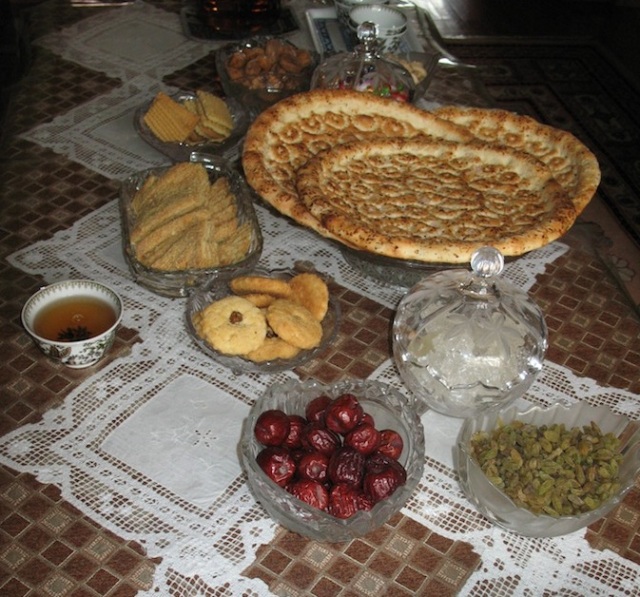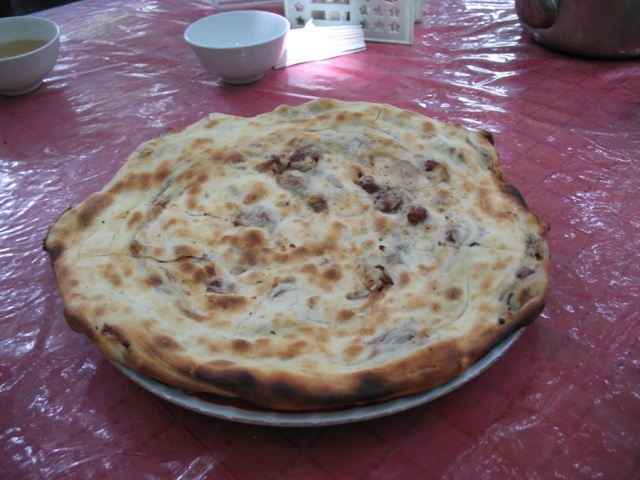I love looking at recipes and cookbooks–especially the kind that explain the unusual elements you are trying to replicate. There are some gems out there for US cookbooks nowadays, with authors that do go through great lengths to explain culture and unique ingredients. What I hate is, “if you don’t have ‘x’ then just use more salt”–recipes pre-adapted for typical American tastes or kitchens. Adapting is totally fine, I just hate it when the reader is not given a proper context of understanding of how their ingredients might differ from those of whatever native region. For that reason, I love shopping for cookbooks in the places where I encounter my food obsessions. I always look for instruction in that region’s native language–with the understanding, of course that the whole idea of cookbooks and DIY is very American. Underrepresented regions of the world, like Xinjiang for example, are publishing interesting cookbooks, and they are much fun to come across.
One of these regional cookbooks that I’d like to share today is in Uyghur, a Central Asian Turkic language, written in the Arabic script. The book was published by the Xinjiang People’s Publishing house in 2007, and it is part of a series on Uyghur culinary culture, by Yunus Hemdulle. It is titled, Nan samsa komechler (flatbreads, meat pies, and buns).

A favorite cookbook from my collection: “Flatbreads, meat pies, and buns” by Yunus Hemdulle (Xinjiang people’s publishing house, 2007)
First of all, notice the language of the title. Nan is of course the same “nan” or “naan” that is pretty much universal for flatbread, as you might recognize from your favorite Indian restaurant. Samsa comes from the same root that “samosa” does. Komech is an outlier here meaning “bun”. Many words in Uyghur have connections to Central Asia, India, and beyond. Why is this? The Turks (whose descendents include the Uyghur, Kazak, Uzbek, Kyrgyz, Turkmen, Tatar, Azeri, Turkish) were powerful armies, and they had at several times throughout history dominated vast lands: from Mongolia to India, from China to Africa. I’m not saying that the root of all things is Turkic, but that interaction of peoples paved the way for many, many linguistic and cultural loans and borrows across Eurasia.
The recipes in this cookbook are meant to be cooked in an Uyghur tonur, or as they say in India, “tandoor”. A tonur is a wood-fire oven that is shaped like a big jar. They can be made out of a variety of materials, from ceramics to iron. A wood fire is stoked on the floor of the oven, and there is usually a box built around the oven to allow for the baker to easier angle themselves to put breads onto the oven’s inside walls. See a video so you can get an idea of this process here, a nan baker from a tourist video in Turpan.
Uyghur breads are made from simple wheat doughs. Yeast, a little salt, a little oil. Occasional other ingredients might be egg, butter or fat, seeds or onions as toppings.
Many traditional Uyghur nan are very thin in the middle, punctured by a device to inhibit the bread from rising while baking. What this amounts to is a ring of puffed bread, and a crater, similar in texture to nearly that of a saltine cracker. This traditional shape is usually marked with a concentric design, and the bread itself can act as serving tray for roasted meats or other dishes, or as a compliment to eat alongside breakfast or lunch tea or with a soup or stew.

Tea time at an Uyghur household: a selection of dried fruits with some beautiful Uyghur nan, with punctured designs
Back when I lived in Guangzhou in the ’90s, typical baked goods were primarily sweet breads and deserts. They were a novelty in a region where most things were cooked on top of a fire or stove (steamed, boiled, or fried). Foreigners, missing salty or savory breads, used to flock to the city’s Muslim quarter (Sanyuanli三元里) to find cheap and delicious wood fire baked breads. Some would buy Uyghur nan flatbreads, in order to decorate them with tomato sauce and cheese to emulate “real” pizza that they remembered from home (as opposed to what was called “pizza” at Guangzhou’s pizza restaurants).
This cookbook begins with an concise history of bread, complete with images of ancient funerary statues of bread bakers. Also in the introduction is, “how to build your own tonur oven,” with a step-by-step photo description on how to do this. I love this. American cookbooks would tell you what things you can buy, and if you can afford it, then you should buy the top-of-the-line version. This book explains how to make what you need, from the most basic ingredients: earth, concrete, a metal ring, and some wood.
Why does tonur/tandoor produce such delicious breads? It’s the same idea as your local neighborhood (if you are lucky) wood fire pizza place. Get a strong wood fire going, keep feeding oxygen to that fire to get it quite hot. Stick some bread dough on the stone walls of the oven. They’ll bake and brown really fast, browning beautifully on the outside while staying moist on the inside. They also retain that wood fire aroma. The bread is peeled off the wall with a big tongs. Classic and delicious.
Unfortunately there isn’t a go-to Uyghur restaurant that I can suggest for you to try this delicious cuisine. It is still largely unknown in the states, and restaurants are rare.
Nan breads, meat pies (samsa) and buns are possible to duplicate in standard US ovens. You won’t have the intense heat of the wood fire, or the smoke, but you can do pretty well baking at high heat on a pizza stone, emulating the shock the dough would get when getting stuck to a tonur wall. Stay tuned for a recipe to make one of the special breads in this cookbook, goshnan, or “meat bread”. Update 22 Feb 2015: I finally posted that recipe. Here is an image of a delicious example that I captured in Urumchi a few years ago:



All of those words, right down to goshnan, are ultimately Persian in origin, but carried by Turkic peoples.
LikeLike
Komech is probably not Persian.
LikeLike
Thanks for pointing this out, pseudoerasmus! Agreed, Persian had a massive influence on languages of Eurasia, and yes, all of these words must have come out of Persian into Central Asia. That said, Turkic influence was strong as well. “Korma”, for example (another Indian restaurant favorite), seems appropriately derived from Turkic “koruma” (grilled/fried). I also thought tandoor was somehow a logical Turkic derivative… And there’s yogurt and the wide variety of dairy items. And just to be clear, I do not mean to be promoting any particular modern nationalist identity and claims toward food–I just love eating–I’m sure you understand.
LikeLike
Didn’t think you’d gone native-nationalist. I was just being pedantic. Yes, kavurma is Turkic, but yogurt is not. It’s Armenian. None of the eastern Turkic languages uses that word. In Uighur it should be gatik or qatik.
LikeLike
yogurt has surely a Turkish etymology! yogrut meant to dense. in thisn context you can look at the English wiord crowd.
https://uzunbacakadem.blogspot.com/2019/08/yogurt-versus-crowd.html
how is the Armenian etymology for that?
LikeLike
Pingback: Uyghur meat bread | Asian Markets of Philadelphia
Pingback: Uyghur meat pies cooked under the broiler | Asian Markets of Philadelphia
Pingback: A childhood comfort food memory via Kashgar flatbread and a savory mutton stew | Asian Markets of Philadelphia
Pingback: Savory Uyghur flatbread at the base of a stew | Asian Markets of Philadelphia